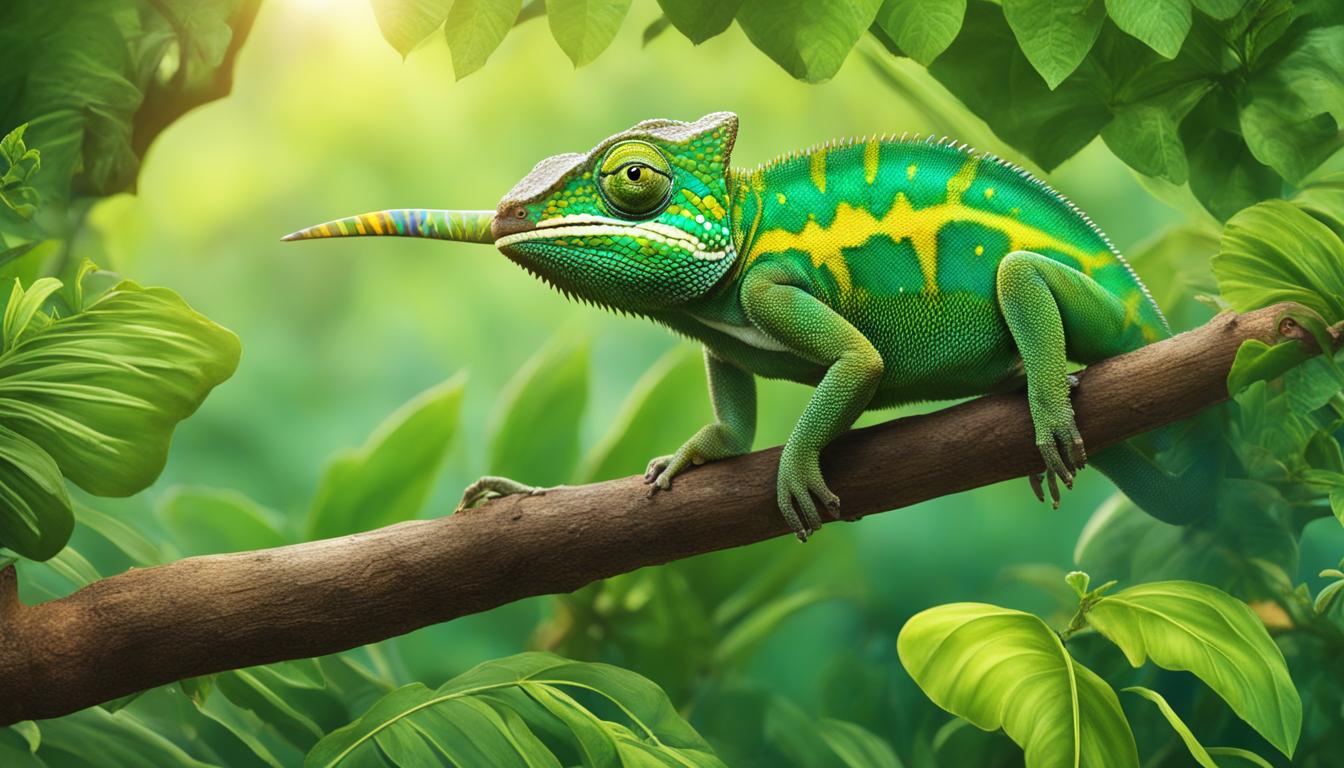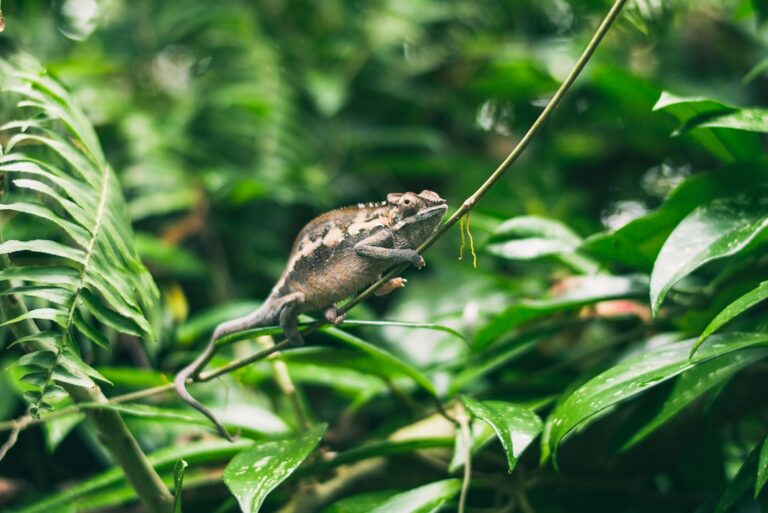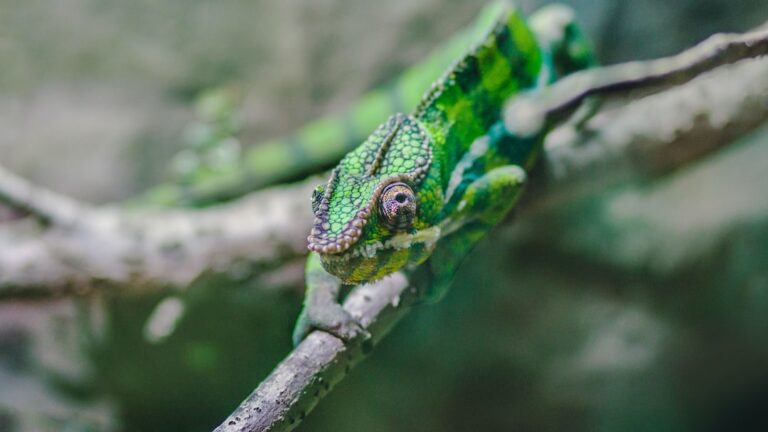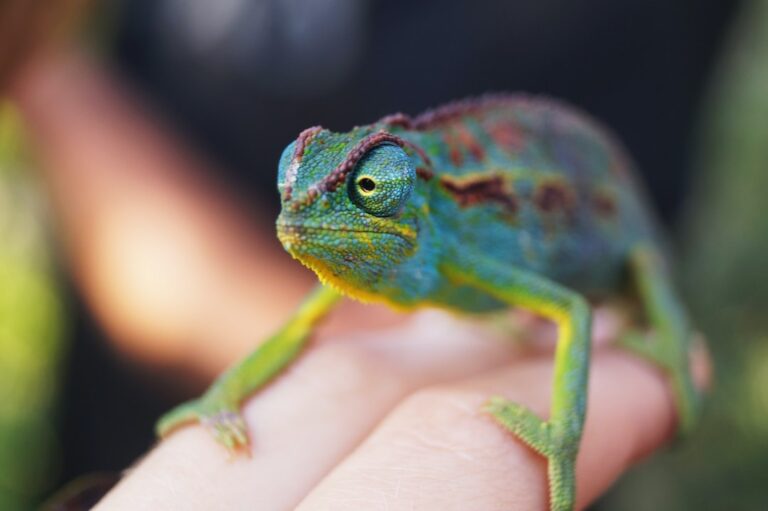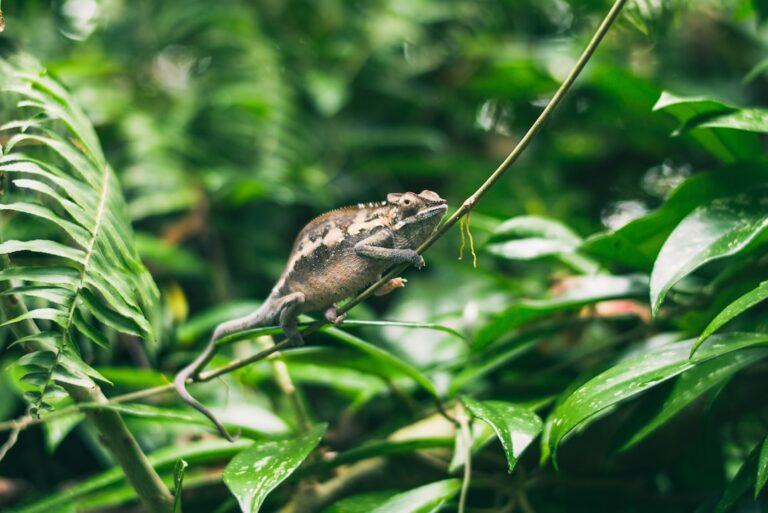Can Chameleons Eat Superworms?
Welcome to our article exploring the question: Can chameleons eat superworms? Chameleons are fascinating reptiles known for their unique appearance and behavior. As insectivores, their diet primarily consists of various types of insects. Pet owners often wonder about the suitability of including superworms in their chameleon’s diet. In this article, we will delve into this topic to provide you with a detailed understanding of whether superworms can be incorporated into a chameleon’s diet.
Table of Contents
Key Takeaways:
- Chameleons are insectivorous reptiles with specific dietary needs.
- Superworms can be included in a chameleon’s diet, but it’s important to consider nutritional balance and safety concerns.
- Proper preparation of superworms, such as gut loading and calcium dusting, can enhance their nutritional value.
- A varied diet that includes a mix of insects and other food sources is crucial for chameleon health and preventing nutritional deficiencies.
- Observing a chameleon’s response to superworms and monitoring their health is essential for maintaining their overall well-being.
Understanding the Dietary Needs of Chameleons
Chameleons have specific dietary requirements to thrive and maintain optimal health. They require a balanced intake of essential nutrients, including protein, fats, vitamins, and minerals. Variety is important in a chameleon’s diet, and insects play a crucial role as a primary source of food.
Essential Nutrients Required
Chameleons require a variety of essential nutrients, including protein, amino acids, calcium, vitamins (such as vitamin A and D3), and minerals (such as phosphorus). These nutrients are necessary for their growth, energy levels, immune function, and overall well-being.
Variety in the Chameleon Diet
Chameleons thrive on a diverse diet that includes a variety of insects, such as crickets, roaches, silkworms, and superworms. Offering a range of food options ensures that chameleons receive different nutrients and helps prevent nutritional deficiencies.
The Role of Insects as Food Source
Insects serve as a crucial food source for chameleons due to their high protein content and nutrient profile. They provide the necessary energy and building blocks for chameleons’ growth, development, and overall health. Insects also simulate natural feeding behaviors and help prevent boredom in captive chameleons.
| Nutrient | Source | Function |
|---|---|---|
| Protein | Insects | Essential for growth and muscle development |
| Calcium | Calcium-rich insects, gut-loaded with calcium | Required for bone development and muscle function |
| Vitamins (A, D3) | Insects, fruits, and vegetables | Supports vision, immune function, and overall health |
| Minerals (phosphorus) | Insects, leafy greens | Important for energy metabolism and cell function |
Nutritional Profile of Superworms
When considering the dietary options for chameleons, it’s important to understand the nutritional content of the feeder insects in their diet. Superworms, in particular, have gained popularity as a nutritious option for reptiles, including chameleons.
Comparing Superworms and Mealworms
Superworms and mealworms are two common feeder insects, but they have distinct differences in their nutritional profiles. While both are suitable for chameleons, it’s essential to understand their unique characteristics.
Superworms are larger in size compared to mealworms, providing a heartier meal option for chameleons. Additionally, superworms have higher fat and protein content, making them more energy-dense and nutritionally dense compared to mealworms.
Protein and Fat Content
Superworms are known for their rich protein and fat content, which are vital nutrients for chameleon health. The high protein content in superworms helps support growth, muscle development, and overall energy levels in chameleons.
However, it’s important to note that the high fat content in superworms means they should be offered in moderation. An excessive intake of fat can lead to obesity and other health issues in chameleons. Therefore, it’s crucial to balance the feeding of superworms with other low-fat options to maintain a healthy diet.
Calcium to Phosphorus Ratio
Calcium is a critical mineral for chameleons, important for proper bone development and muscle function. While superworms contain some calcium, their calcium to phosphorus ratio must be carefully managed to prevent imbalances.
Gut-loading and dusting superworms with calcium powder before feeding them to chameleons ensures a proper calcium to phosphorus ratio. This practice helps provide chameleons with the necessary calcium while avoiding potential issues associated with nutrient imbalances.
Assessing Superworms as a Feeding Option for Chameleons
When considering superworms as a potential food source for chameleons, it is important to evaluate their appropriateness for different life stages and understand chameleons’ affinity towards these insects.
Appropriateness for Different Life Stages
Superworms can be a suitable feeding option for chameleon babies, juveniles, and adults. However, the size and frequency of superworm feedings should be adjusted according to the chameleon’s age and dietary requirements.
Chameleon babies and juveniles have smaller mouths and may struggle to consume larger superworms. In these cases, it is advisable to provide appropriately sized superworms that are easier for them to eat. As chameleons grow, larger superworms can be gradually introduced into their diet.
For adult chameleons, superworms can serve as a regular part of their feeding routine. However, it is still important to offer a variety of other feeder insects to ensure a well-rounded and balanced diet.
Chameleons’ Affinity Towards Superworms
Chameleons, like humans, can have individual preferences when it comes to their food choices. Some chameleons show a strong affinity towards superworms and readily accept them as a food source. This is likely due to the taste, texture, or nutritional content of the superworms.
However, it is important to note that chameleons have varied personalities and tastes. While some may be enthusiastic about superworms, others may show less interest. It is crucial to observe your chameleon’s response to superworms and tailor their feeding plan accordingly.
Superworms can be a valuable addition to a chameleon’s diet, offering a source of protein and other essential nutrients. By considering their appropriateness for different life stages and understanding your chameleon’s preferences, you can provide a balanced and enjoyable feeding experience for your pet.
Safety Concerns with Feeding Superworms to Chameleons
While incorporating superworms into a chameleon’s diet can provide valuable nutrition, there are important safety concerns that chameleon owners need to be aware of. Understanding and addressing these risks is crucial for the well-being of your chameleon.
Choking and Impaction Risks
Superworms are larger and chewier than other feeder insects, which increases the risk of choking or impaction in chameleons. The size and preparation of superworms should be carefully considered to mitigate these risks. It is essential to choose appropriately sized superworms that can be safely consumed by your chameleon.
Potential for Obesity in Chameleons
Due to their high fat content, overfeeding superworms can lead to obesity in chameleons. Obesity poses several health risks, including reduced mobility and an increased susceptibility to metabolic diseases. To prevent obesity, it is crucial to practice portion control and provide a balanced diet that incorporates a variety of feeder insects and nutritious fruits and vegetables.
Superworms and chameleon safety concerns involve the risk of choking and impaction, as well as the potential for obesity. By being aware of these risks and implementing proper feeding practices, you can ensure a safe and healthy diet for your chameleon.
| Safety Concerns | Preventive Measures | |
|---|---|---|
| Choking and Impaction | – Choose appropriately sized superworms | – Monitor feeding to prevent overconsumption |
| Potential for Obesity | – Practice portion control | – Provide a balanced diet with variety |
Gut Loading and Calcium Dusting: Preparing Superworms for Your Pet
Properly preparing superworms before feeding them to chameleons is essential to enhance their nutritional value and promote chameleon health. Superworms can be nutritionally enhanced through a process called gut loading and calcium dusting.
Balancing Superworm Nutrition
When feeding superworms to chameleons, it is important to ensure balanced nutrition. Superworms alone do not provide all the essential nutrients that chameleons require. By incorporating gut loading and calcium dusting, you can enhance the nutritional value of superworms and create a well-rounded diet for your pet.
Gut loading involves feeding the superworms with nutritious foods before offering them to your chameleon. This process allows the superworms to accumulate essential nutrients, such as vitamins and minerals, from the gut-loading foods. High-quality fruits and vegetables can be used for gut loading. You can also supplement their diet with commercial gut-loading products that are specifically designed to provide optimal nutrition.
Calcium dusting is another crucial step in preparing superworms for chameleons. Chameleons require an appropriate calcium to phosphorus ratio in their diet to maintain strong bones and overall health. Dusting the superworms with calcium powder ensures that they provide the necessary calcium for your chameleon. This can be done by placing the superworms in a container with the calcium powder and gently shaking them to allow the powder to adhere to their exterior.
By balancing superworm nutrition through gut loading and calcium dusting, you can provide your chameleon with a diverse and nutrient-rich diet that supports their growth, vitality, and overall well-being.
Methods of Gut Loading
There are various methods and approaches to gut loading superworms, depending on your chameleon’s dietary needs and your specific preferences. Here are a few gut loading techniques that you can consider:
- High-quality fruits and vegetables: Provide superworms with a variety of fresh fruits and vegetables that are high in essential nutrients. Examples include carrots, sweet potatoes, kale, and apples.
- Commercial gut-loading products: Use commercially available gut-loading products that are formulated to provide a balanced and nutritious diet for feeder insects. These products often contain a blend of vitamins, minerals, and other beneficial ingredients.
- Supplements: Consider using supplements such as vitamin and mineral powders to boost the nutritional content of the gut-loading foods.
Experiment with different gut-loading methods to find the approach that works best for you and your chameleon. It is important to provide a variety of gut-loading foods to ensure a well-rounded diet for the superworms and, ultimately, your chameleon.
Can Chameleons Eat Superworms Regularly?
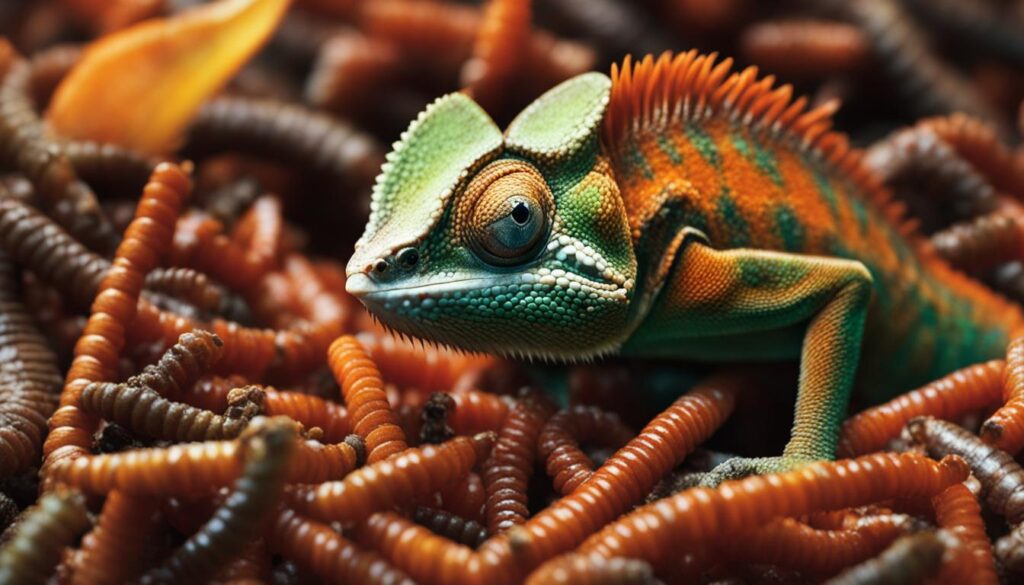
When it comes to feeding chameleons, incorporating superworms into their diet is a common consideration. However, it’s important to determine whether superworms should be offered as staple foods or occasional treats. Additionally, setting up a feeding schedule is crucial for maintaining the health of your chameleon.
Staple Foods Versus Treats
Incorporating superworms as staple foods means providing them as a regular part of your chameleon’s diet. However, it’s essential to balance this with other feeder insects and supplement their diet with a variety of fruits, vegetables, and leafy greens. This ensures your chameleon receives a well-rounded and nutrient-rich diet. On the other hand, offering superworms as treats can provide enrichment and rewards for your chameleon, but they should not make up a significant portion of their diet.
Setting Up a Feeding Schedule
Establishing a feeding schedule is key to preventing overfeeding or underfeeding your chameleon. The frequency of superworm feedings should be tailored to your chameleon’s size, age, and dietary requirements. Ideally, superworm feedings should be spaced out and portioned appropriately. By adhering to a feeding schedule, you can maintain your chameleon’s health and ensure they receive the necessary nutrition without overindulging in superworms.
Regular feeding of superworms to chameleons can be beneficial, but it should be approached with careful consideration. By incorporating superworms as staple foods or occasional treats and establishing a feeding schedule, you can provide your chameleon with a balanced diet that meets their nutritional needs.
Incorporating Superworms into a Varied Chameleon Diet
Superworms can be a valuable addition to a chameleon’s diet when incorporated as part of a diverse and well-rounded meal plan. By creating a balanced diet that combines different feeder insects, chameleon owners can ensure their pets receive a wide range of nutrients and prevent monotony in their feeding routine.
To create a balanced meal plan for chameleons, it is important to include a variety of feeder insects, including superworms. Superworms are rich in essential nutrients such as protein, which is crucial for chameleon growth and overall health. By planning meals that incorporate different insects alongside complementary fruits, vegetables, and supplements, chameleon owners can meet their pets’ dietary needs and promote optimal well-being.
Combining superworms with other feeder insects, such as crickets, roaches, and silkworms, is a great way to diversify a chameleon’s diet. Each insect species provides its own unique set of nutrients, ensuring that chameleons receive a comprehensive nutritional profile. Additionally, incorporating different insects into the diet helps prevent dietary imbalances and encourages natural feeding behaviors in captive chameleons.
By diversifying the chameleon diet with superworms and other feeder insects, chameleon owners can provide a balanced and enriching feeding experience for their pets. This approach ensures that chameleons receive the necessary nutrients for growth, health, and overall well-being.
| Benefits of Incorporating Superworms | Benefits of a Varied Diet |
|---|---|
|
|
Best Practices for Feeding and Storage of Superworms
Implementing best practices when feeding and storing superworms is essential to maintain their nutritional value and ensure the health and safety of chameleons.
Where to Acquire Quality Superworms
It is important to acquire superworms from reputable sources to ensure their health and quality. Trusted pet stores, online suppliers, and breeders can be reliable options for obtaining high-quality superworms.
Optimal Storage Conditions for Superworms
Superworms should be stored under optimal conditions to maintain their viability and freshness. This includes using suitable containers, providing proper ventilation, and keeping them at the appropriate temperature.
Monitoring Your Chameleon’s Health Following Dietary Changes
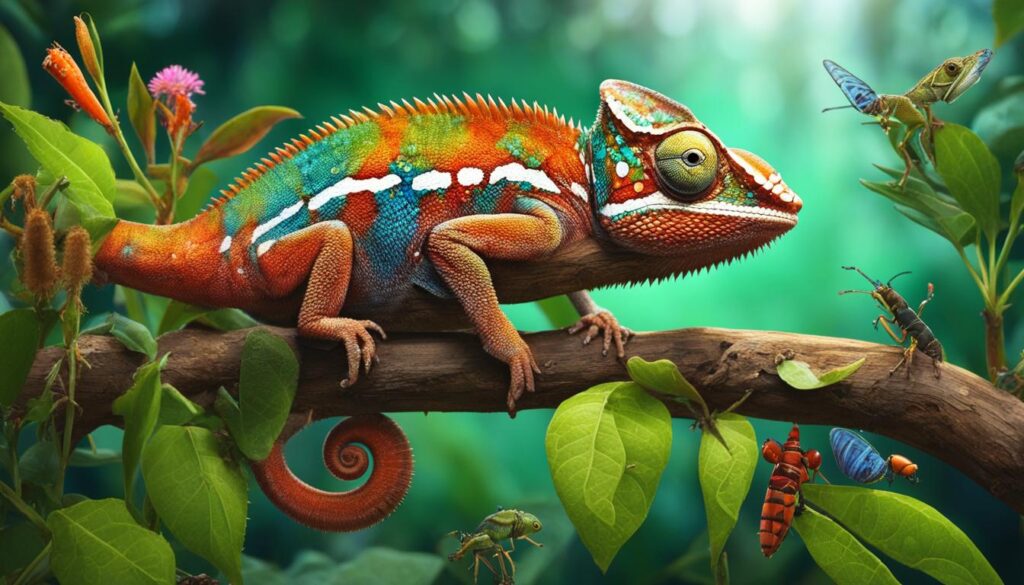
After making dietary changes and incorporating superworms into your chameleon’s diet, it is crucial to monitor their health and assess the effectiveness and impact of the new feeding plan. By closely observing your chameleon, you can identify signs of optimal nutrition as well as red flags that may indicate potential dietary issues or health problems.
Signs of Optimal Nutrition
A chameleon that is receiving proper nutrition will exhibit certain physical and behavioral signs. These signs include:
- Healthy skin and coloration: A well-nourished chameleon will have vibrant and consistent skin coloration, free from any patches or discoloration.
- Good appetite: A chameleon with optimal nutrition will have a healthy and consistent appetite.
- Regular shedding: Shedding is a natural process for chameleons, and regular shedding indicates that their diet is providing the necessary nutrients.
- Active behavior: Chameleons that are receiving proper nutrition will display active and agile behavior.
Red Flags to Watch For
While monitoring your chameleon’s health, it is essential to be aware of red flags that may indicate potential dietary issues or health problems. If you notice any of the following signs, it is important to take appropriate action:
- Weight loss or poor weight gain: Significant weight loss or difficulty in maintaining a healthy weight may indicate dietary issues or underlying health problems.
- Lethargy or decreased activity: A chameleon that is lethargic or less active than usual may be experiencing health issues or inadequate nutrition.
- Changes in appetite or behavior: Sudden changes in appetite, such as loss of appetite or increased aggression, may be signs of underlying health problems.
- Constipation or abnormal droppings: Chameleons should have regular and healthy bowel movements. Constipation or abnormal droppings may indicate digestive issues.
- Physical abnormalities: Any physical abnormalities, such as swelling, sores, or disfigurement, should be investigated as they may be related to nutritional deficiencies or other health concerns.
Monitoring your chameleon’s health and proactively addressing any red flags is crucial for their overall well-being. By staying vigilant, you can ensure that your chameleon receives the proper nutrition and care they need to thrive.
Conclusion
Incorporating superworms into a chameleon’s diet can be a valuable way to provide essential nutrients, such as protein and fat. However, it is crucial to approach feeding responsibilities with care and promote healthy diet choices for these unique reptiles.
By understanding the nutritional profile of superworms and considering safety concerns, chameleon owners can ensure that their pets receive a balanced and enriching diet. It is important to follow best practices for feeding and storage, acquiring superworms from reputable sources, and maintaining optimal storage conditions.
Responsible feeding habits involve balancing superworms with other feeder insects, ensuring a variety of nutritional sources, and monitoring chameleon health for any signs of dietary issues. By prioritizing the overall well-being of chameleons, we can provide them with a diverse and nutritious diet that supports their growth, energy levels, and overall health.
FAQ
Can chameleons eat superworms?
Yes, chameleons can eat superworms as part of their diet.
What are the essential nutrients required in a chameleon’s diet?
Chameleons require protein, amino acids, calcium, vitamins (such as vitamin A and D3), and minerals (such as phosphorus) in their diet.
Why is variety important in a chameleon’s diet?
A varied diet ensures that chameleons receive different nutrients and helps prevent nutritional deficiencies.
What is the role of insects in a chameleon’s diet?
Insects are a primary source of food for chameleons and provide the necessary protein, energy, and nutrients for their growth and overall health.
How do superworms compare to mealworms in nutritional content?
Superworms are larger, have higher fat and protein content, and are slightly more energy-dense compared to mealworms.
What is the calcium to phosphorus ratio in superworms?
Superworms should be gut-loaded and dusted with calcium powder to ensure a proper calcium to phosphorus ratio for chameleon health.
Are superworms appropriate for chameleons of different life stages?
Yes, superworms can be suitable for chameleon babies, juveniles, and adults, with adjustments in size and frequency of feedings.
Do superworms pose any safety concerns for chameleons?
Superworms can pose choking and impaction risks due to their size and chewiness. They can also contribute to obesity if fed excessively.
How should superworms be prepared for chameleon feeding?
Superworms should be gut-loaded with nutritious foods and dusted with calcium powder before being fed to chameleons to enhance their nutritional value.
Can superworms be fed to chameleons regularly?
Superworms can be included as part of a varied and balanced chameleon diet, but portion control, variety, and a feeding schedule should be considered.
How can superworms be incorporated into a varied chameleon diet?
Superworms can be combined with other feeder insects and supplemented with fruits, vegetables, and leafy greens to provide a well-rounded and nutritious diet.
What are the best practices for feeding and storing superworms?
Superworms should be acquired from reputable sources and stored under optimal conditions to maintain their viability and freshness.
How can the health of chameleons be monitored after dietary changes?
Signs of optimal nutrition, such as healthy skin and coloration, good appetite, regular shedding, and active behavior, can indicate that a chameleon’s dietary needs are being met.
What is the role of superworms in a chameleon’s diet?
Superworms can provide essential nutrients for chameleons when incorporated responsibly into a varied diet, promoting their health and well-being.
How can responsible feeding habits be encouraged for chameleons?
Balancing superworm nutrition, monitoring chameleon health, and prioritizing a diverse and well-rounded diet are essential for responsible feeding of chameleons.

